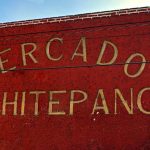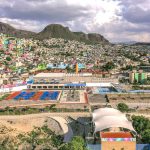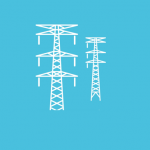 The Xalpa Cablebús is the important transfer station for those hoping to cover the entire line. Fortunately, it’s just a matter of getting out of one car and into another a few steps away.
The Xalpa Cablebús is the important transfer station for those hoping to cover the entire line. Fortunately, it’s just a matter of getting out of one car and into another a few steps away.
The station is named for the giant Xalpa neighborhood that grew in the 1970s. Streets extend well south onto the slopes of the Tecuauhtzin Volcano. Like in the other better known Xalpas, San Pedro in Azcapotzalco, and San Mateo in Xochimilco, the Nahuatl world “Xalpa” here means simply “on the sand.”
Passengers arriving are dropped nearly directly onto the Avenida de las Minas, the avenue of the mines. And this reminds us of the area’s long history with mineral extraction. Sand was just one of the more common materials sought at the end of the avenue. That same street will eventually lead one well up into the Sierra de Catarina volcanoes.
The station logo presents the so-called False Chameleon once common in the area.
The Xalpa Cablebús station, on Cablebús Line 2, has radically changed the neighborhood. It will continue to change over the coming years.

Nearest at 0.25 kms.

Nearest at 0.43 kms.

Nearest at 0.98 kms.

Your first stop in Iztapalapa, the fantastic Cablebus...

The plumed serpent just north of the Xaltepec Volcano...

Crossing the towers into the true southeast of Iztapalapa...

The neighborhood on the slopes of the famous Cerro de la Tortuga...

Santa Martha's start to a journey across southeastern Iztapalapa...